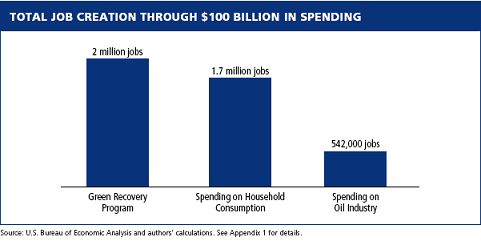Yesterday, the Center for American Progress released “Green Recovery,” a new report by Dr. Robert Pollin and University of Massachusetts Political Economy Research Institute economists. This report demonstrates how a new Green Recovery program that invests $100 billion over two years would create 2 million new jobs with a significant proportion in the struggling construction and manufacturing sectors. It is clear from this research that a strategy to invest in the greening of our economy will create more jobs, and better jobs, compared to continuing to pursue a path of inaction marked by rising dependence on fossil fuel billionaires.

To create 2 million new jobs within two years, the overall level of fiscal expansion will need to be around $100 billion, or roughly the same as the portion of the April 2008 stimulus program that was targeted at expanding household consumption. This green economic recovery program will create more jobs and better paying jobs. If Congress decided, as part of a domestic oil production and gas price reduction effort, to spend $100 billion on new oil and gas subsidies that subsidize gasoline and oil prices, only a quarter as many jobs would be created:

The plan calls for most of the stimulus to go directly to the private sector, with $50 billion for tax credits and $4 billion for federal loan guarantees. $46 billion in direct government spending would support public building retrofits, the expansion of mass transit, freight rail, smart electrical grid systems, and new investments. This $100 billion investment is targeted at six key sectors in building a green economy today:
- Retrofitting buildings to improve energy efficiency
- Expanding mass transit and freight rail
- Constructing smart electrical grid transmission systems
- Wind power
- Solar power
- Next-generation biofuels
The Green Recovery program is part of a comprehensive low-carbon energy strategy and could be paid for with proceeds from auctions of carbon permits under a greenhouse gas cap-and-trade program.
Center for American Progress President and CEO John Podesta explains why the time for a green recovery is now:
It is time for a new vision for the economic revitalization of the nation and a restoration of American leadership in the world. We must seize this precious opportunity to mobilize the country and the international community toward a brighter, more prosperous future. At the heart of this opportunity is clean energy, remaking the vast energy systems that power the nation and the world. We must fundamentally change the way we produce and consume energy and dramatically reduce our dependence on oil. The economic opportunities provided by such a transformation are vast, not to mention the national security benefits of reducing oil dependence and the pressing need to fight global warming. The time for action is now.
In a press briefing introducing the report [mp3], Leo Gerard, International President of the United Steelworkers of America, said: “The point of view of the Steelworkers is quite simple: An energy-efficient green economy creates jobs, and creates jobs in America.”
When asked what are the minimum steps Congress and the president must take this session, Van Jones (Green For All) and Frances Beinecke (NRDC) identified three key elements:
- Congress needs to appropriate funds ($125 million) for the Green Jobs Act.
- Congress needs to appropriate funds for the Energy Efficiency and Conservation Block Grant.
- Congress needs to renew and extend the production and investment tax credits for renewable energy.
Conservatives in Congress are threatening to filibuster these efforts, and President Bush is threatening vetoes — even to shut down the government to protect oil companies at the expense of everyone else.
Join the Green Jobs Now Day of Action on September 27 to spread the word across the country.
State fact sheets [PDFs]: Alaska | Arizona | Arkansas | California | Colorado | Florida | Illinois | Indiana | Iowa | Kansas | Maine | Maryland | Massachusetts | Michigan | Minnesota | Missouri | Montana | Nebraska | Nevada | New Hampshire | New Jersey | New Mexico | New York | North Carolina | North Dakota | Ohio | Oregon | Pennsylvania | South Carolina | Tennessee | Virginia | Washington | West Virginia | Wisconsin

